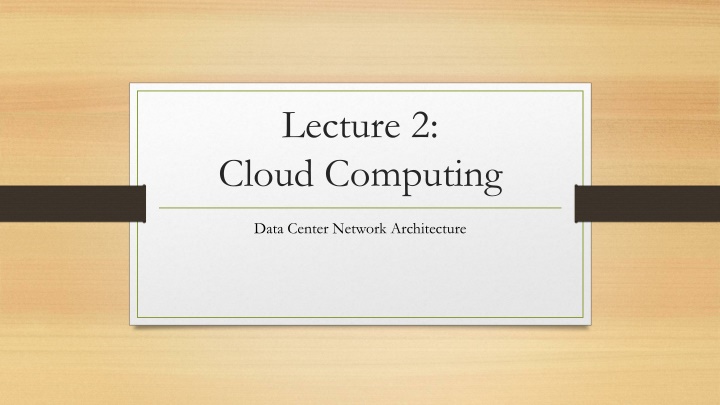
Cloud Computing Data Center Network Architecture Insights
Explore the key aspects of cloud computing data center network architecture including elasticity, multi-tenancy, service models (IaaS, PaaS, SaaS), DC networking vs. long haul network, scalability, virtualization, and tiered architecture.
Download Presentation

Please find below an Image/Link to download the presentation.
The content on the website is provided AS IS for your information and personal use only. It may not be sold, licensed, or shared on other websites without obtaining consent from the author. If you encounter any issues during the download, it is possible that the publisher has removed the file from their server.
You are allowed to download the files provided on this website for personal or commercial use, subject to the condition that they are used lawfully. All files are the property of their respective owners.
The content on the website is provided AS IS for your information and personal use only. It may not be sold, licensed, or shared on other websites without obtaining consent from the author.
E N D
Presentation Transcript
Lecture 2: Cloud Computing Data Center Network Architecture
Cloud Computing, Common Needs Elasticity Resources only when needed, on-demand utility/pay-per-use Multi-tenancy Independent users result in need for security and isolation, while shring and amortizing costs for efficiency. Resilience and Manageability Isolate failures, replication and migration.
Service Models Infrastructure as a Service (IaaS) Supply virtualized resources, e.g. S3 or EC2 Platform as a service (PaaS) Let users focus on what they are delivering, not the resources needed to deliver it, e.g. Google s AppEngine, Salesforce, Microsoft Azure, Amazon Web Services Software as a Service (SaaS) Software is delivered via the cloud, e.g. fee for use. Consider GoogleApps, Microsoft 360, etc.
DC Networking vs Long Haul Network Long haul: Speed of light is significant source of latency, unlikely to be resolved soon With a DC, distances are short, the speed of light is less of a factor Serialization/Deserialization delay (bits/second) is a factor Long haul: Shortest path is not uncommon and likely best Within a DC, tree-like topologies can concentrate traffic, generating bottle necks DCs have unique concerns: Multiple tenants and elastic demand, resulting in need for security and efficient provisioning and security.
From Many Comes One Scaling, Robustness, Availability improved when service is provide by many aggregating interchangeable parts, rather than queuing for one, or a small number, of whole providers Easier to add more parts Easier to service parts Easier to dial up and dial down
Virtualization is Key Enabler Use independent of physical resources Multiple users per machine Isolation Migration Virtual Heterogeneity or Homogeneity Virtual CPUs, storage volumes, networks, etc.
Tiered Architecture The old standby Redundant core routers connect DC to Internet Aggregation layer cross-connects to core routers and Access switches Hence Levels 2 and 3 Access layer , such as top of rack, connects to servers and cross-connects to Aggregation layer Layer 2
Tiered Architecture Attributes Redundancy at the top Massive scale at the bottom Manageable complexity Fail soft for most important, higher level resources
Tiered Architecture Limitations Higher up gets over-subscribed since everything passes through Over-subscription increases with scale Most important paths are most over-subscribed
Level-2 vs Level-3 Level 2 is faster, cheaper, and easier to manage Level 3 scales better, because it is hierarchical Level 3 can manage potential congestion through routing Multipath routing via equal cost multipath
Fat Tree Each layer has the same aggregate bandwidth Communication within a pod stays within a pod Need to be careful about purely equal-cost paths or there will be reordering Pre-bakes the paths to ensure diversity, while maintaining ordering
Fat Tree Details K-ary fat free: three layers (core, aggregation, edge) Each pod consists of (K/2)2servers and 2 layers of K/2 K-port switches. Each edge switch connects (K/2) servers to (K/2) aggregator switches Each aggregator switch connects (K/2) edge and (K/2) core switches (K/2)2core switches, each ultimately connecting to K pods Providing K different roots, not 1. Trick is to pick different ones K-port switches support K3/4 servers/host: (K/2 hosts/switch * K/2 switches per pod * K pods)
Path Diversity Path diversity is good, in that it distributed hot spots, enabling, for example, equal cost. But, if equal cost is only goal, there could be a lot or reordering. Ouch! Fat Tree uses a special IP addressing and forwarding scheme to address this (pardon the pun), and additionally, allow intra-pod traffic to stay intra-pod
Special IP Addressing 10.0.0.0/8 private addresses Pod-level uses 10.pod.switch.1 pod,switch < K Core-level uses "10.K.j.i K is the same K as elsewhere, the number of ports/switch View cores as logical square. i, j denote position in square. Hosts use 10.pod.switch.ID" addresses 2 <= ID <= (K/2) K=1 is pod-level switch; ID > 2 is too many hosts 8-bits implies K < 256
Static Routing Via Two-Level Lookups First level is prefix lookup Used to route down the topology to end host Second level is a suffix lookup Used to route up towards core Diffuses and spreads out traffic Maintains packet ordering by using the same ports for the same endhost
Flow Classification Type of diffusion optimization Mitigate local congestion Assign traffic to ports based upon flow, not host. One host can have many flows, thus many assigned routings Fairly distribute flows (K/2)2shortest paths available but doesn t help if all pick same one, e.g. same root of multi-rooted tree Periodically reassign output port to free up corresponding input port
Flow Scheduling Also a Diffusion Optimization Detect and deconflict large, long-lived flows Threshholds for throughput and longevity
Fault tolerance Can reject flows by setting cost to infinity. Plenty of paths, if failure Maintain sessions across switches to monitor
